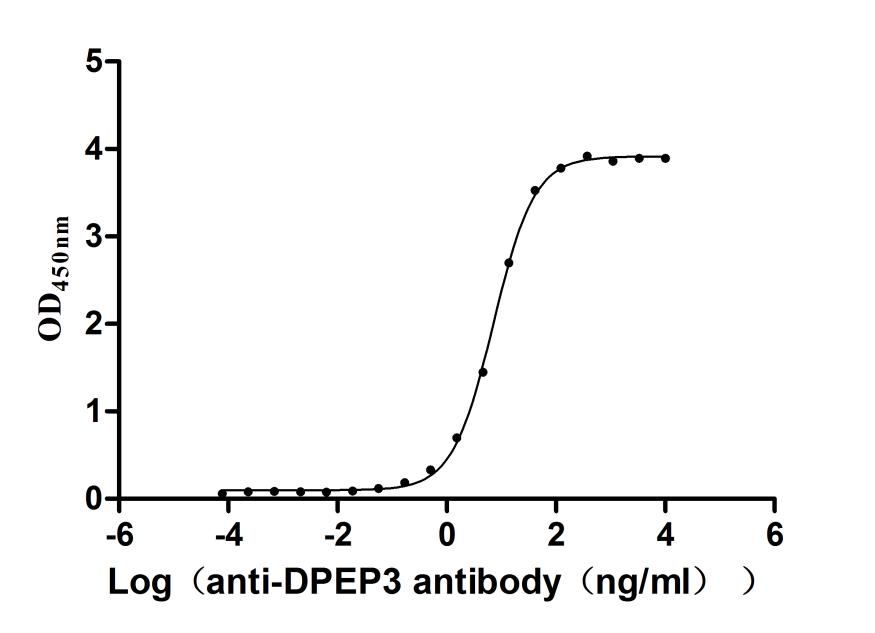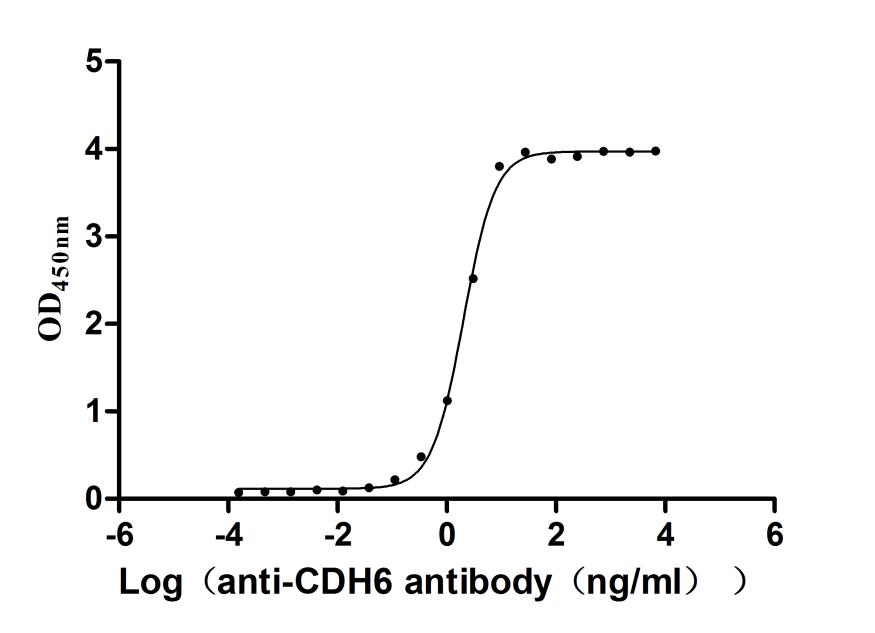Recombinant Mouse Protein S100-B (S100b)
-
货号:CSB-YP020643MO
-
规格:
-
来源:Yeast
-
其他:
-
货号:CSB-EP020643MO-B
-
规格:
-
来源:E.coli
-
共轭:Avi-tag Biotinylated
E. coli biotin ligase (BirA) is highly specific in covalently attaching biotin to the 15 amino acid AviTag peptide. This recombinant protein was biotinylated in vivo by AviTag-BirA technology, which method is BriA catalyzes amide linkage between the biotin and the specific lysine of the AviTag.
-
其他:
-
货号:CSB-BP020643MO
-
规格:
-
来源:Baculovirus
-
其他:
-
货号:CSB-MP020643MO
-
规格:
-
来源:Mammalian cell
-
其他:
产品详情
-
纯度:>85% (SDS-PAGE)
-
基因名:S100b
-
Uniprot No.:
-
别名:S100bProtein S100-B; S-100 protein beta chain; S-100 protein subunit beta; S100 calcium-binding protein B
-
种属:Mus musculus (Mouse)
-
蛋白长度:Full Length of Mature Protein
-
表达区域:2-92
-
氨基酸序列SELEKAMVA LIDVFHQYSG REGDKHKLKK SELKELINNE LSHFLEEIKE QEVVDKVMET LDEDGDGECD FQEFMAFVAM VTTACHEFFE HE
-
蛋白标签:Tag type will be determined during the manufacturing process.
The tag type will be determined during production process. If you have specified tag type, please tell us and we will develop the specified tag preferentially. -
产品提供形式:Lyophilized powder
Note: We will preferentially ship the format that we have in stock, however, if you have any special requirement for the format, please remark your requirement when placing the order, we will prepare according to your demand. -
复溶:We recommend that this vial be briefly centrifuged prior to opening to bring the contents to the bottom. Please reconstitute protein in deionized sterile water to a concentration of 0.1-1.0 mg/mL.We recommend to add 5-50% of glycerol (final concentration) and aliquot for long-term storage at -20℃/-80℃. Our default final concentration of glycerol is 50%. Customers could use it as reference.
-
储存条件:Store at -20°C/-80°C upon receipt, aliquoting is necessary for mutiple use. Avoid repeated freeze-thaw cycles.
-
保质期:The shelf life is related to many factors, storage state, buffer ingredients, storage temperature and the stability of the protein itself.
Generally, the shelf life of liquid form is 6 months at -20°C/-80°C. The shelf life of lyophilized form is 12 months at -20°C/-80°C. -
货期:Delivery time may differ from different purchasing way or location, please kindly consult your local distributors for specific delivery time.Note: All of our proteins are default shipped with normal blue ice packs, if you request to ship with dry ice, please communicate with us in advance and extra fees will be charged.
-
注意事项:Repeated freezing and thawing is not recommended. Store working aliquots at 4°C for up to one week.
-
Datasheet :Please contact us to get it.
相关产品
靶点详情
-
功能:Weakly binds calcium but binds zinc very tightly-distinct binding sites with different affinities exist for both ions on each monomer. Physiological concentrations of potassium ion antagonize the binding of both divalent cations, especially affecting high-affinity calcium-binding sites. Binds to and initiates the activation of STK38 by releasing autoinhibitory intramolecular interactions within the kinase. Interaction with AGER after myocardial infarction may play a role in myocyte apoptosis by activating ERK1/2 and p53/TP53 signaling. Could assist ATAD3A cytoplasmic processing, preventing aggregation and favoring mitochondrial localization. May mediate calcium-dependent regulation on many physiological processes by interacting with other proteins, such as TPR-containing proteins, and modulating their activity.
-
基因功能参考文献:
- Data (including data from studies in knockout mice) suggest that S100b acting as a humoral factor impairs glycolysis in muscle (myoblasts, myotubes, and skeletal muscles) independent of insulin action; this effect appears to be due to inhibition of Gapdh activity from enhanced poly(ADP-ribosyl)ation of Gapdh. (S100B = S100 protein, beta polypeptide, neural; Gapdh = glyceraldehyde-3-phosphate dehydrogenase) PMID: 28174179
- S100B inhibits C3H/10T1/2 murine embryonic mesenchyma.l cells into osteoblasts. S100B stimulates C3H/10T1/2 cell differentiation into adipocytes. PMID: 27601207
- The results of this study showed that S100B affects behavioral despair in female mice through functional interaction with the 5-HT7 receptor. PMID: 26499172
- Data show that S100B has direct effects on macrophages, enhancing particularly CCL22 and IL-1beta expression and modulates the inflammatory response in uveoretinitis and this is likely to be, at least in part, via a direct effect on macrophages. PMID: 26204512
- Data show that high glucose increased protein-protein interaction between Steap4 and S100B in mesangial (MES13) cells. PMID: 25817898
- high glucoseinduced profibrotic genes (TGFbeta, type IV collagen and fibronectin) and cell hypertrophyrelated p21WAF1 are dependent on S100B. PMID: 25482070
- Data suggest up-regulation of S100b/RAGE (advanced glycosylation end-product receptor) signaling plays role in inflammatory interaction between adipocytes/macrophages; adipocyte secretion of S100b is up-regulated by Tnf (tumor necrosis factor-alpha). PMID: 23804363
- Gioma production of S100B enhancestumor growth through CCL2 upregulation and tumor-associated macrophages chemoattraction. PMID: 23719262
- HMGB1, S100B, and RAGE signaling modulate the hippocampal inflammatory response and might play key roles in surgery-induced cognitive decline. PMID: 23899512
- S100B is a proinflammatory cytokine bridging RAGE and CD166/ALCAM downstream effector mechanisms, both being compensatory upregulated after genetic deletion of its counterpart. PMID: 23729438
- S100B expression may serve to modulate cardiac metabolism and adverse consequences of AGE in diabetic post-MI remodeling and function PMID: 23000886
- S100B is expressed in mouse photoreceptor cone outer segments but not in rods. PMID: 22508049
- The RAGE pathway may play an important role in STAT3 induction in glioma-associated macrophages and microglia, a process that may be mediated through S100B. PMID: 21264954
- S100B and APP levels are simultaneously increased within Down syndrome neural progenitors, their secretions are synergistically enhanced in a paracrine fashion, and their overexpressions disrupt mitochondrial membrane potentials and redox states. PMID: 21779383
- Unlike in the hippocampus-dependent tasks, S100B-KO mice were indistinguishable from wild-type mice in both cerebellum-dependent motor coordination and delay eyeblink conditioning. PMID: 21146588
- Data support S100B inhibition as a novel strategy for reducing cortical plaque load, gliosis and neuronal dysfunction in Alzheimer disease (AD) and suggest that both extracellular as well as intracellular S100B contribute to AD histopathology. PMID: 21080947
- These results suggest that S100beta is important for brain development and establishment of proper brain functions. PMID: 20099023
- Given the crucial roles of COX-2, IL-1beta and TNF-alpha in the inflammatory response, we propose that, by engaging RAGE, S100B might play an important role in microglia activation in the course of brain damage. PMID: 18599158
- attenuates the hemodynamic response to catecholamines PMID: 19713945
- constitutive overexpression of S100beta in transgenic mice does not modify serotonin levels during development, nor does it protect the serotonergic neurons from selective neurotoxicity or modify the serotonergic sprouting induced by partial lesion. PMID: 11835317
- The distribution of serotonergic fibers in the brains of S100B-knockout mice was normal. S100B may not influence neurite extension of serotonergic neurons PMID: 11872254
- Glial protein S100B modulates long-term neuronal synaptic plasticity PMID: 11891290
- the major cytoplasmic S100B target protein in different glial cell lines in the presence of Zn(2+) and Ca(2+) is IQGAP1 PMID: 12377780
- These results implicate normal levels of S100B in the attenuation of epileptogenesis. PMID: 12393261
- the -1,669/+3,106 sequence of the S100B gene is a useful reagent for driving expression of transgenes in most S100B-expressing cells of mouse brain. PMID: 12561079
- S-100b-containing cells and GFAP-containing cells increased in the striatum and substantia nigra at 3 days after MPTP treatment. S-100 immunoreactivity was observed only in GFAP-positive astrocytes. PMID: 12673835
- S-100 beta overexpressing animals were more active than the CD-1 control animals and showed significantly less social sniffing. PMID: 12742260
- Our findings show increased clusterin expression in the aged S100B mice compared to their CD-1 controls, a finding we have interpreted as further evidence of pathological brain aging. PMID: 15126113
- results support the idea that elevated levels of S100B in the brain are associated with increased vulnerability to neurological injury PMID: 15236402
- Mice lacking S100B show an apparent delay in OPC maturation in response to demyelinating insult. Nuclear S100B participates in the regulation of oligodendroglial cell maturation. PMID: 15555923
- 5-HT may modulate glial morphology by inducing a release of intracellular S-100B, and this pathway is inoperable in the S-100B knockout (-/-). PMID: 15621007
- These results argue against the current view that S100B expression is restricted to the astrocytic lineage in the CNS, and indicate that the use of S100B in combination with other molecular markers will help discriminate oligodendrocytes from astrocytes. PMID: 15782413
- Our data are consistent with a model in which S-100B overexpression in AD enhances glial activation and leads to an augmented neuroinflammatory process that increases the severity of neuropathologic sequelae. PMID: 15810011
- Altogether, our results indicate that the S100B expression defines a late developmental stage after which GFAP-expressing cells lose their NSC potential and suggest that S100B expression is repressed by adult SVZ microenvironment. PMID: 17078026
- possible interaction between FGF-2 and S100Beta in activated satellite cells of the dorsal root ganglia, which might trigger paracrine actions in the axotomized sensory neurons PMID: 17729158
- S100B has a role in exacerbating brain damage and periinfarct reactive gliosis (astrocytosis and microgliosis) during the subacute phase of middle cerebral artery occlusion PMID: 18451356
- There was a significant increase of hippocampal BDNF (+53%) and a decrease of hippocampal (-12%) and residual neocortical (-15%) NA in 10-month-old S100B KO mice compared to wildtype mice. PMID: 18638525
- Our findings suggest further investigation into the potential role of vitamin E in reducing the oxidation state of the S100B protein and its influence on neuroinflammatory processes marked by microglial activation in vivo. PMID: 18649404
- The data of this study indicated that genetic differences in S100B gene expression may predispose individual differences in the responsivity to repeated intake of MDMA. PMID: 18812013
显示更多
收起更多
-
亚细胞定位:Cytoplasm. Nucleus.
-
蛋白家族:S-100 family
-
组织特异性:Although predominant among the water-soluble brain proteins, S100 is also found in a variety of other tissues.
-
数据库链接:
KEGG: mmu:20203
STRING: 10090.ENSMUSP00000047968
UniGene: Mm.235998
Most popular with customers
-
Recombinant Rabbit Tissue factor pathway inhibitor (TFPI) (Active)
Express system: Mammalian cell
Species: Oryctolagus cuniculus (Rabbit)
-
Recombinant Human Tissue factor pathway inhibitor (TFPI), partial (Active)
Express system: Mammalian cell
Species: Homo sapiens (Human)
-
Recombinant Human CUB domain-containing protein 1 (CDCP1), partial (Active)
Express system: Mammalian cell
Species: Homo sapiens (Human)
-
Recombinant Human Carcinoembryonic antigen-related cell adhesion molecule 8(CEACAM8) (Active)
Express system: Mammalian cell
Species: Homo sapiens (Human)
-
Recombinant Human CD70 antigen (CD70), partial (Active)
Express system: Mammalian cell
Species: Homo sapiens (Human)
-
Recombinant Human Dipeptidase 3(DPEP3), partial (Active)
Express system: Mammalian cell
Species: Homo sapiens (Human)
-
Recombinant Macaca fascicularis Dipeptidase 3(DPEP3) (Active)
Express system: Mammalian cell
Species: Macaca fascicularis (Crab-eating macaque) (Cynomolgus monkey)
-
Recombinant Mouse Cadherin-6(Cdh6),partial (Active)
Express system: Mammalian cell
Species: Mus musculus (Mouse)




















